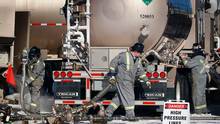How rising well costs are reshaping the oil patch
 What’s the biggest generational shift in the oil and gas industry?
What’s the biggest generational shift in the oil and gas industry?Don’t feel bad if you guessed either hydraulic fracturing, horizontal drilling or drilling multiple wells from the same location (pad drilling). Asian investment or rising production from the oil sands would be impressive choices. However, the answer lies where the bit hits the ground hardest - the capital cost of drilling a well.
A well in western Canada today, on average, costs three times as much to drill and complete as it did six years ago (see attached Figure 1). The big ramp up in the transition period between 2004 and 2010 – from $1.3-million to $3.6-million per well – was not because of general inflation, but the quick migration into the capital-intense world of unconventional plays like shale gas and light, tight oil (LTO).
Like Sir Isaac Newton proved, for every action there is a reaction; the quick tripling of the upfront need for capital is causing major ripples in the character of the Canadian oil and gas industry. Here are six notable reactions:
Greater vulnerability to weak commodity prices– Steep production declines are a hallmark of unconventional wells; it’s not uncommon for a well’s output to fall off by 80 per cent just one year after it comes online. There is a narrow window of time after well completion for a company to generate enough cash flow to fund drilling of the next expensive hole. If commodity prices are weak immediately after initial production, the company will never recover it’s upfront investment fast enough to keep drilling. As such, companies can easily find themselves in a position where they have a strong inventory of prospective wells but are too cash poor to drill them.
Need for more upfront capital – Entrepreneurial companies have been the fabric of western Canada’s oil and gas industry for more than a century. Up until 10 years ago, a few million dollars scrounged up from friends, family and a retail stockbroker would put an entrepreneur in business – complete with a membership to the Petroleum Club. By five years ago, the starting ticket had risen to $50-million. Now, to pay for a multi-well program that mitigates the risk of failure, initial capitalizations are running $100-million to $200-million. That’s a bit rich for most uncles and cousins – and the club membership is extra.
More reliance on deep-pocketed investors– Private equity firms and other moneyed institutions are backing most of today’s entrepreneurial companies. But it’s not only startups that are sourcing deep pockets. Larger independents are tapping Asian investors for the bigger ante required to participate in expensive and unconventional resource plays. Everyone needs more money.
Need for stronger balance sheets– Oil and gas companies are well known to spend all their cash flow, plus more. The greater sensitivity to commodity prices as described above means that there is a greater need to hold a larger reserve of capital to sustain drilling and production if prices fall.
Tendency to get bigger – The ratcheting up front-end capital costs, combined with the assembly-line-style operations of today’s drilling programs, points to an industry that will be increasingly reliant on achieving economies of scale to compete. “Bigger is better,” will be a theme that amplifies through the decade. Expect to see more consolidation as the industry eats its young to gain advantage.
Lower well counts– Not long ago, the oil field service industry considered 12,000 well completions in a year to be a disaster. Normally, 15,000 was a good year. Now, higher well costs and constant budgets are forcing service providers in the field to retool their equipment for greater efficiency and a new normal of 10,000 wells a year.
It’s survival of the fittest for all oil field service companies and their producing customers, and disaster will fall on those who don’t adapt. When they finish Newton, add Charles Darwin to the reading list.
You can return to the main Market News page, or press the Back button on your browser.

